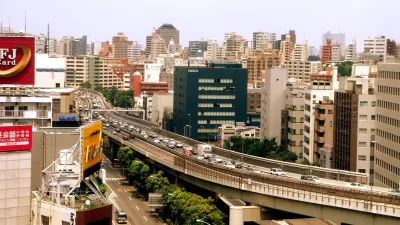Transportation planners who thought the current job climate couldn't possibly get worse may want to ignore this piece. John Metcalfe reports on studies that show slime is just as effective in planning the path of an urban rail system as humans.
In case you needed more convincing that the design of urban rail systems follows some supreme natural order comes this item in The Atlantic Cities. John Metcalfe spotlights the work of "protist-obsessed" scientist Atsushi Tero, who has led research into "the path-finding ways of Physarum polycephalum, the "many-headed slime," which survives by sending out tendrils in all directions in the quest for food."
In one stunning experiment, "researchers arranged little oat flakes on a gel in the same pattern of real cities near Tokyo in the Kanto region.
Then they stimulated a slime mold to grow from the center outward,
connecting with all the delicious Oatvilles in a highly precise and
unappetizing game of connect-the-dots. The whole process took just over a
day, and at the end there was the environs of Tokyo, outlined in ooze. (Abstract and study.)"
Researchers that have been working with slime molds believe they, "can create much more effective networks than even the most advanced technology that currently exists," and argue that, "molds
will one day serve in place of human brains and computers when it comes
to designing networks, whether for public transit or power lines or
something else."
FULL STORY: Mapping Tokyo's Train System in Slime Mold

Alabama: Trump Terminates Settlements for Black Communities Harmed By Raw Sewage
Trump deemed the landmark civil rights agreement “illegal DEI and environmental justice policy.”

Planetizen Federal Action Tracker
A weekly monitor of how Trump’s orders and actions are impacting planners and planning in America.

The 120 Year Old Tiny Home Villages That Sheltered San Francisco’s Earthquake Refugees
More than a century ago, San Francisco mobilized to house thousands of residents displaced by the 1906 earthquake. Could their strategy offer a model for the present?

In Both Crashes and Crime, Public Transportation is Far Safer than Driving
Contrary to popular assumptions, public transportation has far lower crash and crime rates than automobile travel. For safer communities, improve and encourage transit travel.

Report: Zoning Reforms Should Complement Nashville’s Ambitious Transit Plan
Without reform, restrictive zoning codes will limit the impact of the city’s planned transit expansion and could exclude some of the residents who depend on transit the most.

Judge Orders Release of Frozen IRA, IIJA Funding
The decision is a victory for environmental groups who charged that freezing funds for critical infrastructure and disaster response programs caused “real and irreparable harm” to communities.
Urban Design for Planners 1: Software Tools
This six-course series explores essential urban design concepts using open source software and equips planners with the tools they need to participate fully in the urban design process.
Planning for Universal Design
Learn the tools for implementing Universal Design in planning regulations.
Clanton & Associates, Inc.
Jessamine County Fiscal Court
Institute for Housing and Urban Development Studies (IHS)
City of Grandview
Harvard GSD Executive Education
Toledo-Lucas County Plan Commissions
Salt Lake City
NYU Wagner Graduate School of Public Service





























